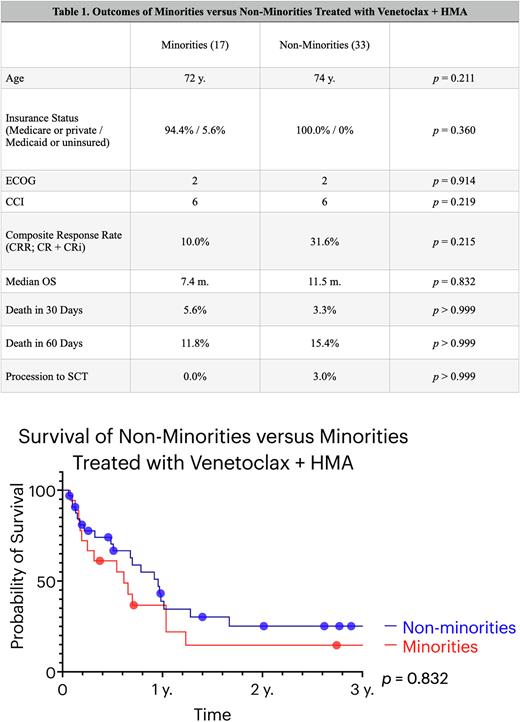Abstract
Background: The BCL-2 antagonist, venetoclax, is a new addition to the armamentarium in the treatment of acute myeloid leukemia (AML). However, access to care, insurance coverage, and procession to stem cell transplant (SCT) limit survival among minorities in AML. We have previously demonstrated differential survival in AML among minorities with respect to ELN cytogenetic risk. The aim of this study is to observe the impact of healthcare disparities among minority patients treated with venetoclax-based regimens.
Patients & Methods: We analyzed 51 patients that underwent treatment for AML with venetoclax in combination with a hypomethylating agent (HMA; decitabine or azacitidine) from January 2016 to December 2021 at VCU Massey Cancer Center. Patients were divided into two cohorts: those that self-reported as minorities and those that self-reported as White, which we defined as non-minorities. Baseline demographics were obtained, including age, performance status, and insurance type, as well as disease characteristics, including molecular profiling either through PCR, NGS, or both at the time of induction, alongside cytogenetic risk, doses of induction regimens, response, and survival. Patients were considered evaluable for response if there was a bone marrow biopsy following a minimum of 28 days of treatment. The event for calculating the overall survival (OS) was the date of death. Patients were otherwise censored at the date of last contact.
Results: The non-minority cohort that self-identified as White consisted of 33 patients. The median age was 74 years, the median ECOG score was 2, and the median Charlson Comorbidity Index (CCI) score was 6. All patients (100.0%) had Medicare or private insurance. ELN cytogenetic risk in the non-minority cohort was favorable in 4 (12.1%), intermediate in 6 (18.2%), and adverse in 21 (63.6%). Two patients (6.1%) had unknown ELN risk. The composite response rate (CRR; CR + CRi) at the time of the 28-day marrow was 31.6%. The rate of death at 30 days was 3.3% and death at 60 days was 15.4%. The median OS of the non-minority cohort was 11.5 months. One patient (3.0%) in the non-minority cohort proceeded to stem cell transplant. The minority cohort consisted of 18 patients with a median age of 72 years, median ECOG score of 2, and a median CCI score of 6. No significant differences were observed between these cohorts for these parameters, as demonstrated in Table 1. Seventeen patients (94.4%) in minority cohort had Medicare or private insurance. There was no significant difference in insurance coverage between both cohorts (p = 0.360). ELN cytogenetic risk in the minority cohort was favorable in six (33.3%), intermediate in 3 (16.7%), and adverse in 7 (39.9%). Two patients (11.1%) had unknown ELN risk. At the time of the 28-day marrow, one patient achieved CRi for a CRR of 10.0%. The rate of death within 30 days was 5.6% and 11.8% within 60 days. The median OS in the minority cohort was 7.4 months, although not significantly shorter than the non-minority cohort (p = 0.215).
Conclusions: We previously demonstrated that pervasive healthcare disparities exist among minority patients with AML versus non-minorities. In those studies, insurance coverage and procession to stem cell transplant was associated with trends toward increased survival in the non-minority cohorts. However, in this study, no such differences in insurance coverage or procession to stem cell transplant were observed. In turn, while the median OS numerically favored the non-minority cohort, the difference was not significant. Although further conclusions are limited by sample size, given our prior work, these findings suggest that transplant and access to insurance coverage may have partially accounted for survival differences.
Disclosures
Maher:BMS: Research Funding.
Author notes
Asterisk with author names denotes non-ASH members.


This feature is available to Subscribers Only
Sign In or Create an Account Close Modal